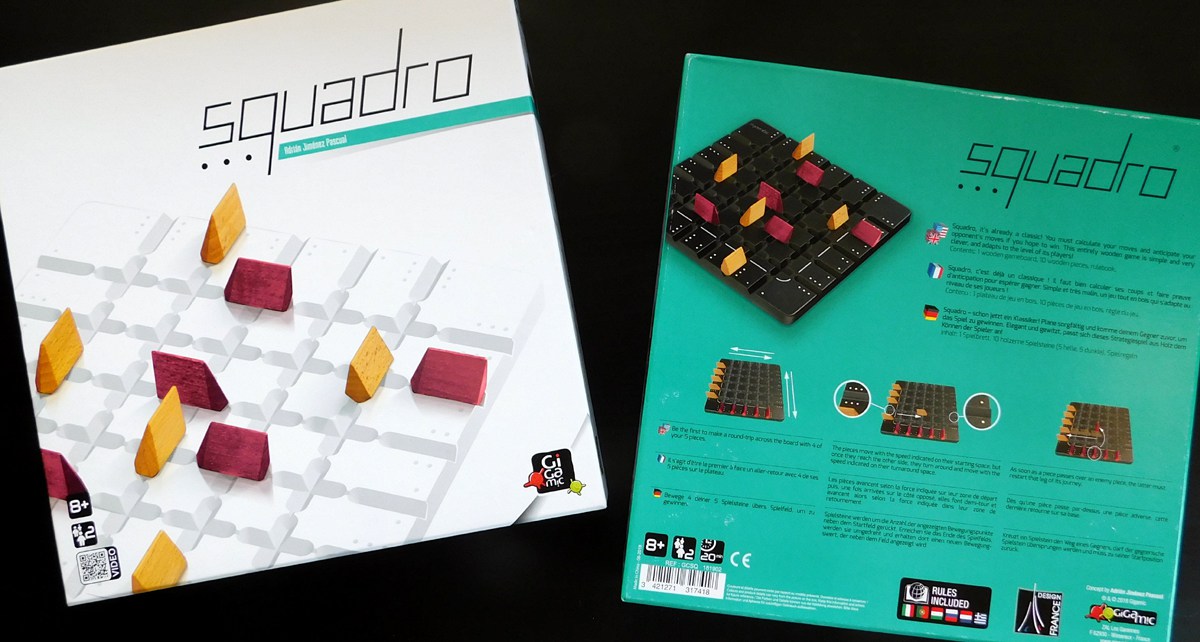
The first game that I truly fell in love with was a little abstract strategy title called Quarto. I was about 8 years old and one of my father’s students (my father is a college professor) brought it with him one night when he visited the house for dinner and taught it to us. It was a revelation to my young brain: only a few rules, only a few turns (the game can, at most, last 16 turns), yet it provided strategic depth like something I’d never known. Now, some 20+ years later, the very same publisher is still putting out hits like it.
What Is Squadro?
From French publisher and abstract powerhouse Gigamic and designer Adrián Jiménez Pascual, Squadro is a strictly 2-player (as the best abstract strategy games are) game for ages 8 and up that plays in, at most, 20 minutes. It will be releasing in October and, if it’s anything like the other titles in their abstract line, will likely retail for around $35-$40 which, given the love and care with which they produce their games, is a more than fair price.
Squadro is at once beautiful and simple. It features a hefty wooden board with five channels running horizontally and another five vertically across the board. Into these channels fit the game pieces, 10 little wooden pieces (5 black and 5 white) that vaguely resemble little boats, a resemblance borne out by the aim of the game: sail across the board and back before your opponent does.

Playing Squadro
To be more specific, the aim of the game is to be the first player to cross the five spaces of the board’s center, turn around in their little port on the other side, and return back to their starting space with four of their five pieces. On each turn, a player will select one of their pieces and advance them a certain number of spaces towards either the far side or, if they’ve already made their turn, back home.
Here’s where the intrigue starts, because not only will the pieces in different channels move different numbers of spaces, but the distance they can travel on their turn also varies depending on whether they’re coming and going. See, each dock (I’m completely fabricating the nautical theme, but for reference’s sake it makes explaining the game easier, so bear with me) is marked by a number of pips ranging from 1 to 3, and that number represents how far the piece in that channel can move on its turn.

Each player will have two speedy channels that can move across the board in great leaps of 3 at a time, making short work of the 5-space distance if they so choose. They will also have a more conservative 2-space channel, which can still make the trip in just a few turns if left undisturbed. And lastly they will have two laborious, languid 1-space-per-turn channels that will feel like they’re moving in quicksand. Until, of course, they reach the opposite side and the tables turn.
Because once a piece reaches the opposite port, they turn around to begin their return journey and their speeds may change. While the 2 remains the same (good old reliable 2!), the 1s becomes 3s and visa versa. So while you can shoot your 3s across the board like a bullet, you will do so knowing full well that the return journey will take several times as long… and that’s only if you’re lucky, and let me tell you, you won’t be.
Because here’s the thing: if you thought this sounded simple and even a little bit boring so far, you’re absolutely right. But there’s a cutthroat side of the game in the form of jumping, the classic checkers mechanism in which you leapfrog an opponent’s piece and, in this case, send it back from whence it came.
If you ever pass over another player’s piece (or, if you would land on it, you automatically pass over it to the next space), you send it back to the start of whichever side it is currently coming from. So while you can’t send a ship that’s made its turn all the way back, you will still have plenty of options to put a damper on your opponent’s travels.

Should You Buy Squadro?
I have a particular fondness for abstract strategy games because they are incredibly easy to teach new players or non-gamers but, despite that, the good ones don’t have to sacrifice strategy or depth in order to get there, and Squadro fits right in alongside those good ones. Earlier I mentioned Quarto, a much older game from the same company that, after over two decades of play, I still haven’t mastered. Granted, I’ve only been playing Squadro for about a month, but it has already shown me flashes of those qualities that will make it heavily replayable.
Immediately, you are faced with decisions about whether to play offensively and rush your 3s across, or maybe defensively and try to bait your opponent out and then leap them to send their pieces back. Then, as you look at it, you begin to doubt yourself. Was what you considered offensive play (blitzing out with your fastest pieces) actually the opposite? Because those 3s suddenly become 1s when they reach the other side and are easy targets trying to make their way back.

So, to compensate, you try to push your slowest pieces across first, nudging and cajoling them like a mother duck. And, just when that 1 is about to make its glorious transformation into a 3… your opponent swoops in out of nowhere and sends it right back to back. And that, far more than seeing a 2 or 3 returned, stings. Because at the end of the day Squadro is easily, pleasingly quantifiable. You can measure your success by the amount of stoppage inflicted upon your opponent.
While it’s always kind of nice to send a piece back to the start of their row, it’s clearly more valuable (and, deep down, much more satisfying) to send back a 1 that’s progressing nicely than a 3 that’s about to turn. Because the 1 is an investment, each space it has passed representing not only a turn spent to usher it along but also another turn that player will have to spend if you send it home. And while it stings when it happens to you, nothing takes away the somewhat-sadistic rush of doing it to your opponent.
If you haven’t already figured it out, this game won’t be for everyone. A lot of players don’t like cutthroat, in-your-face board games that promote player backstabbing and sabotage. That kind of strategy is too stressful and that’s fair. For me, however, it doesn’t bother me in this setting because it’s equitable. There are no dice impartially favoring one player over the other. There is no deck of cards that can unwittingly crown one player with a lucky draw. At the end of the day there’s just you and the person sitting across from you, and if that other player beats me, well… then they were the better player that time and I can’t wait to regroup, learn, and play again.
And that’s what Squadro is: a vicious little skirmish that you will want to play again. And again. And again.

![]() To subscribe to GeekDad’s tabletop gaming coverage, please copy this link and add it to your RSS reader.
To subscribe to GeekDad’s tabletop gaming coverage, please copy this link and add it to your RSS reader.
Click here to see all our tabletop game reviews.




